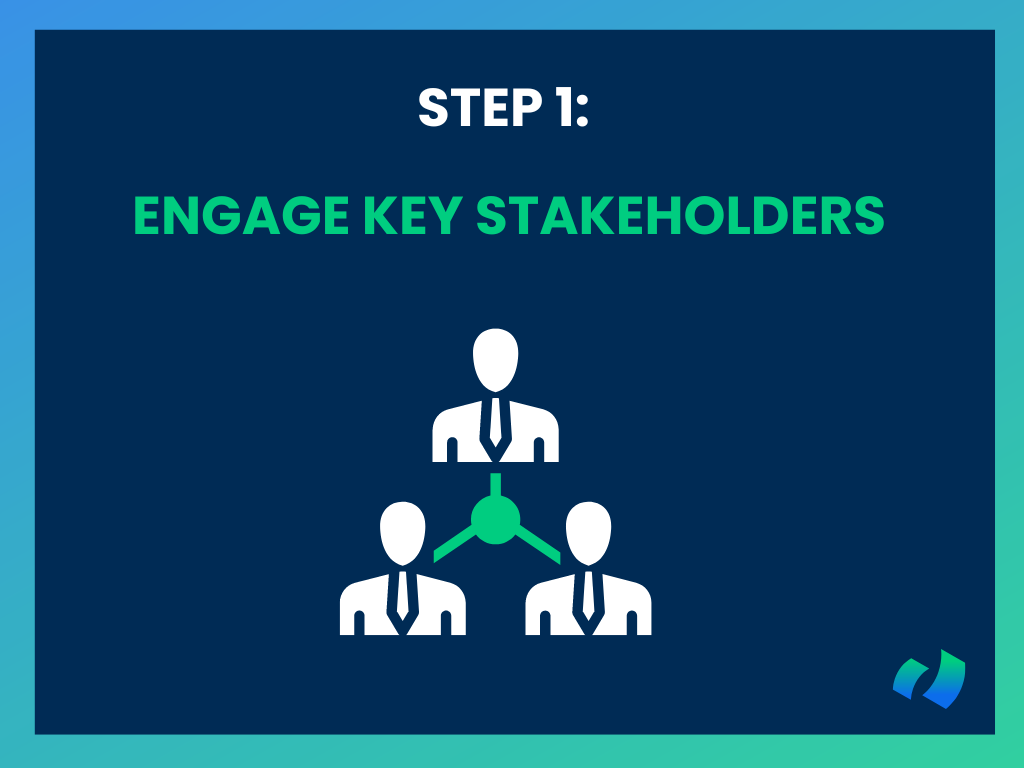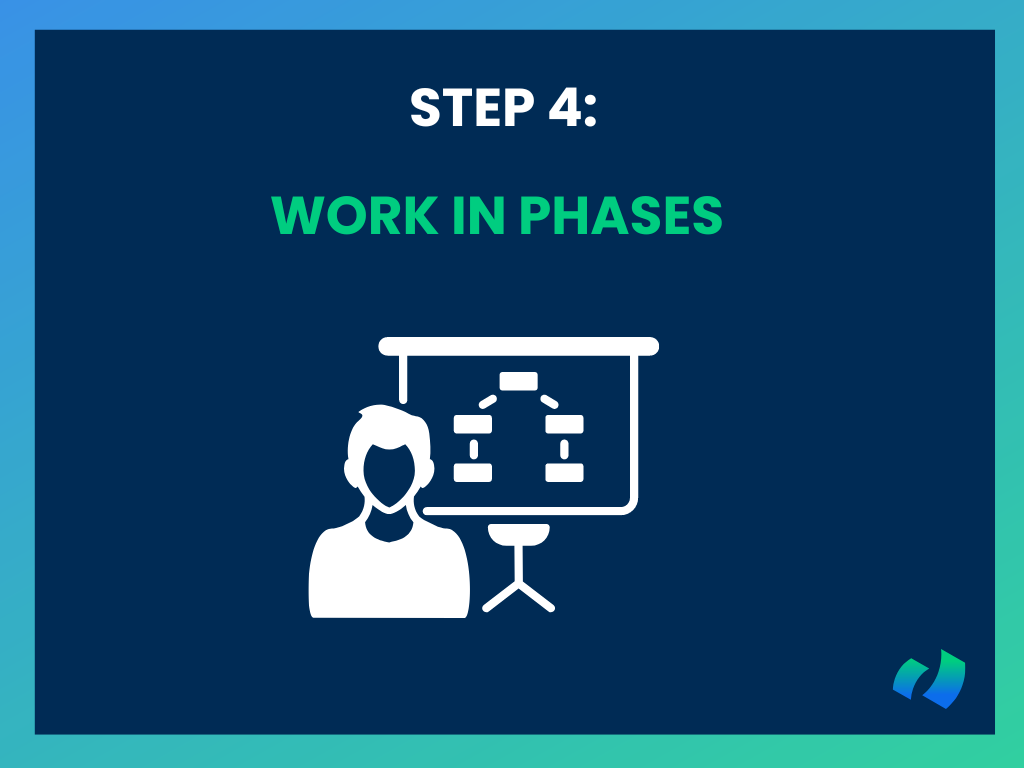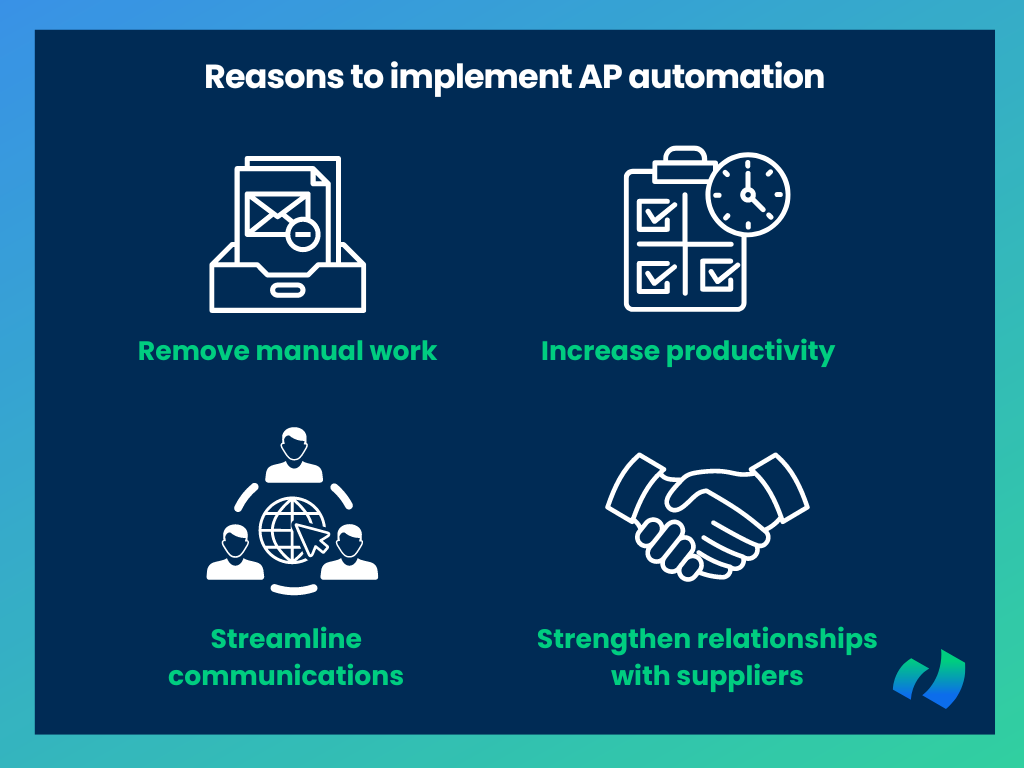Good CFOs are always looking for ways to improve the productivity of their finance team, reduce unnecessary costs and increase efficiency. Adopting automation technologies like accounts payable (AP) automation can improve accuracy and speed up AP workflows, so your team doesn’t have to waste time chasing down invoices or dealing with late payments.
Accounts payable automation can help organizations streamline their financial processes and save time, money, and resources. Benefits are undeniable, but every significant change usually brings some resilience, and getting your team to adopt new technologies can be challenging.
Investing in new technology takes time, patience, coordination with internal stakeholders, training routine…and the list goes on. It’s easy to understand why some teams might be hesitant at first – it all adds up quickly!
The key to successfully implementing AP automation is effective communication and a clear understanding of the benefits. In this blog post, we’ll dive into some strategies that can help you successfully implement AP automation in your organization and get your team on board.
Common Challenges In Implementing AP Automation

Team resistance
One of the most significant obstacles that organizations face when implementing AP automation is a certain level of resistance from employees. Humans are creatures of habit and we often find comfort in our traditional and familiar ways of working, so don’t be surprised if your employees are hesitant to change and don’t see the value in the new technology solutions.
Finance teams can be resilient to implement AP automation for several reasons. The transition from manual processes can take time and require staff retraining. There are also concerns that the new AP solutions are often complex and require extensive setup. Lastly, many simply feel too comfortable or resistant to change with the way they have been doing things the same way for years.
With all these considerations in mind, it’s understandable why your team may initially be unhappy with a new development. But with the right planning and preparation, they will embrace the change and recognize how AP automation can help save time and money in the long run.
Lack of budget
Implementing new technology in any organization is a big challenge, especially when there’s no budget for it. One of the most significant struggles for AP departments is the lack of budget to implement automation.
Without proper funds to make the required investments, it can be difficult to harvest all of the automation benefits and AP teams are stuck with manual and labor-intensive tasks that can take time and resources away from other projects. The larger the accounts payable department gets, compounded with an increase in manual AP processes and data entries, the longer it will take without adequate budget resources to make a real change.
While there may be ways around this issue, like taking advantage of free trials or exploring open-source software, these aren’t always viable options in the long term.
To implement AP automation successfully, you will need to secure dedicated funding, because, without it, your team will be severely limited in their ability to upgrade their operations.
Data integration and migration
Concerns about data integration and migration often present a challenge for AP teams. In fact, this can be the trickiest piece of AP automation implementation.
Organizations may have to migrate large amounts of data from their existing accounting systems to new, unfamiliar ones, which can be time-consuming and complex. For example, accounts must be set up and integrated with ERP systems to capture invoices and payments. All business data needs to be checked for accuracy and integrity, as wrong or incomplete information may cause major issues.
To overcome this, organizations can consider using data migration tools, which can automate the process of migrating data. When you start your automation journey, it’s smart to seek the help of experts who have experience in data migration, to ensure a smooth migration process and to make sure none of the existing payment processes will break when you implement a new solution.
Security and compliance
Finally, there are compliance and security challenges. The new AP automation solution may require organizations to comply with new regulations and ensure the security of their financial data.
Organizations can ensure that the new software is compliant with all relevant regulations, such as data protection laws, and that it provides the necessary security features, like encryption and access controls. It’s desirable to conduct regular security audits to identify potential vulnerabilities and take corrective actions.
To manage security and compliance effectively, you must decide which standards you want to implement, develop and maintain detailed security guidelines, secure employee accounts through strong authentication protocols, regularly monitor accounts for suspicious activity, and more. It’s a lot of work that requires time and resources, but it’s also critical for ensuring smooth AP automation.
How to Get Your Team to Adopt AP Automation
Here are a few basic steps to help you bring your team on board and introduce them to AP automation:
- Engage key stakeholders
- Communicate the benefits
- Provide training and support
- Work in phases
- Be patient
- Show the results
- Reward and recognize

Here is where it all starts. First and the most important step in getting your team to adopt AP automation is to identify the key stakeholders and include them in the process from the very beginning.
These are the individuals who will be most affected by the change and who will have the most influence over the adoption process. It’s crucial to involve them in the planning and implementation. As one of our clients stated in a recent case study, bringing the whole team on board and working together to find the best solution is what makes all the difference.
The best practice is that all members of the AP team are involved from the beginning to make sure that the transition goes smoothly and that the system works best for everyone involved.
Share the vision of what accounts payable automation can do for your team, get everyone onboard with it, and plan together how this will improve your workflows and payment processes, reduce administrative burdens and increase efficiency. Taking the time to inform not only helps ensure good implementation but also secures that employees know how to make the most of the new automation tools.
Involving people throughout the entire process means that any issues that may arise can be identified early on and quickly addressed. It also gives employees a sense of ownership and confidence in their ability to use the new system properly. As AP automation continues to gain traction, paying attention to collaboration ensures success.

Introducing AP automation is a challenge that many organizations struggle with as there needs to be a concerted effort across teams to educate on the process and how it will benefit them – this is an important piece of the puzzle.
AP automation provides the ability to improve accuracy and increase efficiency. It eliminates manual tasks with error-prone steps, reduces reliance on paper documents, and streamlines approval processes.
By eliminating redundant paperwork and mundane tasks, AP automation frees up resources for other pursuits that add value, like analyzing invoice data to uncover trends or implementing stronger audit practices. It allows teams to shift their focus from manual processing to more meaningful activities which can lead to lower operational costs and improved customer service.
It is essential to communicate the benefits to the team to make them understand how this will make their job easier and more productive. Explain to the team how AP automation can help streamline processes and save time so that they’re not bogged down with tedious tasks or vulnerable to making mistakes. Highlight the time and cost savings, better control, faster processing, and enhanced compliance and security that the new system will bring.
Ultimately, when everyone understands why the new AP automation solution is being implemented and how it will assist them, your team can truly understand its potential and be motivated to make it work for you.

Training and support will ensure that team members are comfortable with the tools they are using to automate the accounts payable process, allowing for a successful transition more quickly than otherwise possible.
The use of the new technology may require your employees to learn new skills and processes, so it’s important to provide them with the resources they need to adopt the new system. This includes providing them with training on how to use it, as well as ongoing support as they begin to use it in their day-to-day work. Providing support such as help desk services will guarantee any technical questions can be swiftly answered, allowing the whole process to run smoothly.
When team members understand how automation works, they are more likely to understand how their responsibility fits into the big picture, and be able to adjust properly for changes.
Quality training and support offered during the adoption period will give your team confidence in new automated solutions, reducing their time-to-value and helping them reap the rewards sooner rather than later.

AP automation can seem like a complex process, but taking it step-by-step and working in phases is the most efficient way to go for it. Phasing out workflows allows organizations to gradually adapt to the new system, minimize disruptions in daily operations, test and gather feedback, build support, ease the learning curve and prioritize the most critical process.
By breaking down the process into smaller, more manageable pieces, you can plan ahead and accurately assess and allocate resources throughout each phase.
This organized, phased approach provides the opportunity to receive feedback from your team once they start to use it, which can help to identify any issues or problems with the system early on and make necessary adjustments before the system is fully implemented. It also allows AP staff to prioritize effort and quickly respond to challenges that could arise during implementation.

Patience is required when introducing new technologies, so CFOs should take a slow, deliberate approach rather than trying to rush their way to success.
When it comes to AP automation, patience has many forms. You need to be patient with the technology, with your team, but also with yourself.
It can be tempting to dive into a project without the proper research or without having a thorough understanding of accounts payable best practices and processes. Instead, you should devote time to investigate AP automation software and options carefully, to make sure you choose the one that works well with your company’s existing financial structure.
Allow time for adoption and be patient as the team adjusts to the new system and learns how to use it in their day-to-day work. Knowing that such transformation takes time is key to realizing the full potential of AP automation.

Every proud CFO should show the results of a successfully implemented AP automation, as it demonstrates the tangible benefits of the new system, like increased efficiency, cost savings, and better compliance and security.
This can encourage the team to fully adopt and embrace this new technology, build support for the project, motivate the team and demonstrate a positive impact on the business.
Presenting valid results is essential for the CFO to demonstrate the value of the system to the AP team, and can also help to justify the investment and demonstrate its value to leadership.
Showing the accounts payable team the results of their hard work is an incredibly important gesture by the CFO that can help unify and motivate them. Seeing tangible evidence of their accomplishments, whether it be increased accuracy, reduced labor costs, or improved customer satisfaction ratings can give them the morale boost and sense of accomplishment needed to stay engaged and motivated going forward.

When your staff feels appreciated for their hard work, it lifts their spirits and often brings about improved attitudes. Acknowledging employees for their accomplishments helps make them feel valued, which in turn will pay off in increased productivity.
Reward and recognize team members who have successfully adopted the new system and who have made valuable contributions along the way. Make sure to highlight the good work of your team during and after the implementation process to strengthen their morale, inspire performance, and boost engagement.
The nice practice of rewarding and recognition enforces a positive culture, where working together is more likely to result in successful projects. Taking the time to recognize achievements encourages more creativity and innovation, more engagement, and more work toward achieving long-term goals.
Rewards can include incentives like bonuses, promotions, extra days off, or some other form of incentives. Recognition can be something simple like public acknowledgment, such as sending out an email or making an announcement in a meeting. By rewarding and recognizing team members who have adopted the new system, you can encourage others to follow and create a culture of adoption.
Are You Ready To Kick-Off Your AP Automation Journey?
Take a moment to consider whether your organization is ready for automation. Did you assess the current state of your processes, identify areas that can be improved, and evaluate the resources and budget required for implementation? Do you have the support and buy-in from leadership and key stakeholders?
If you still hesitate or something is still missing, here are a few more arguments for why you should implement AP automation:

- Remove manual work: Eliminate time-consuming tasks like data entry and invoice matching, freeing your team to focus on more strategic initiatives.
- Increase productivity: Automated processes speed up approvals and payments, reducing bottlenecks and improving overall efficiency.
- Streamline communications: A centralized platform ensures better visibility and smoother collaboration between teams, reducing errors and miscommunication.
- Strengthen relationships with suppliers: Timely, accurate payments foster trust and loyalty, ensuring a stronger, more reliable supplier network.
AP automation offers significant benefits to your team and organization.
Cloud-based solutions like DOKKA empower your finance team to focus on strategic initiatives by eliminating the burdens of manual AP management. It’s a modern, efficient solution designed to help businesses save time, reduce costs, and boost productivity.
Ready to take the next step? Book a demo today to see how DOKKA can transform your accounts payable process.




